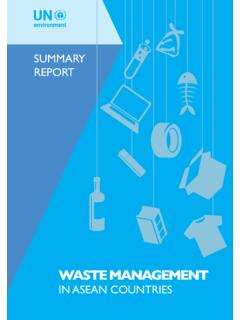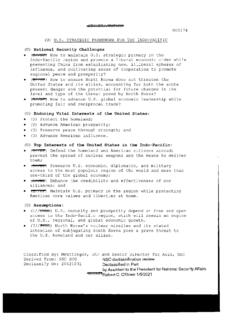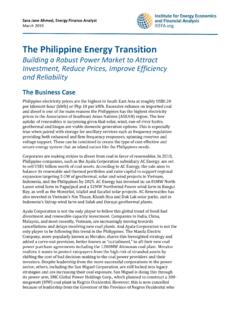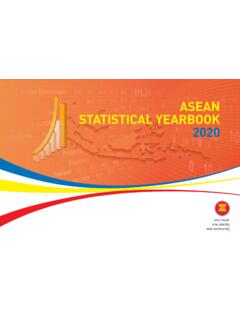Transcription of Entrepreneurship in the Philippines
1 DEVELOPING FILIPINO ENTREPRENEURS: CASE-BY-CASE By Nathan Rauh-Bieri December 9, 2016 Entrepreneurship in the Philippines The Philippines recently posted economic growth, its fastest quarter in three years and the strongest in Asia. Despite its outperforming economy, however, the archipelago has not enjoyed a reputation for Entrepreneurship . Is there reason for that to change? According to recent studies, the answer is both yes and no. While it is true that this rising star of the Pacific has seen an uptick of entrepreneurialism, considerable challenges await Filipinos who try to launch their own enterprise.
2 In 2014, Global Entrepreneurship Monitor (GEM) delivered a report on the state of Entrepreneurship in the Philippines , a thick account of the entrepreneurial ecosystem. This report narrowed down the main determinants of entrepreneurial activity to two: 1) the country s social values toward Entrepreneurship ; and 2) individuals psychology, demographic characteristics, and motivations. Among asean ( association of southeast asian nations ) countries, Filipinos reported the strongest entrepreneurial intentions and perceived capabilities and They generally considered Entrepreneurship a good career choice, one well supported within society.
3 Moreover, Filipinos registered a lower fear of failure often a significant barrier to entrepreneurial activity than other nationalities in the These are positive indicators, especially paired with the country s economic growth. Ryan Evangelista of the Center for International Private Enterprise (CIPE) put some numbers to these hopeful signs: In 2011, there were approximately 830,000 business enterprises in the Philippines . Of these, percent are classified as micro, small, and medium sized enterprises (MSME) which are responsible for 38 percent of total job growth.
4 Even though large firms create a lot more jobs, the high percentage of MSMEs indicates high entrepreneurial activity overall. Where, then, do the challenges lie? The GEM report notes a main weakness of the entrepreneurial ecosystem: poor provision of training aimed at expanding and sustaining businesses. It goes on: While many Filipinos have positive views about the prospect of becoming entrepreneurs because they believe they have the capabilities to match the opportunities and start businesses, their actual capabilities to continue and grow their businesses remain According to this, cultural support for Entrepreneurship is not lacking training is.
5 Entrepreneurial spirit is only as useful as the skills to back it up. Some key facts support this claim. Despite having a comparatively high rate of early stage Entrepreneurship , the rate of businesses that survive at least years in the Philippines is low, compared to its asean Moreover, among these same countries, it has the highest business discontinuance rate. v Finally, less than 1% of Filipino entrepreneurs aspire to create 20 or more jobs within the next five years, also one of the lowest rates among asean Taken together, this presents an underwhelming picture: few entrepreneurs actually sustain new enterprises, and even fewer create more jobs.
6 There are some explanations for this apparent contradiction in the ecosystem. One is the barrier to entry the steps required to incorporate and legally register a new enterprise. The 2016 Doing Business Report ranks the Philippines a poor 165 out of 189 countries for ease of starting a business. The barrier to entry disproportionately affects those looking to begin an MSME. But it is not the only challenge to Entrepreneurship in the Philippines . Evangelista also cites rule of law, physical and social infrastructure, domestic macro environment, and global macro environment; a level playing field, access to financing, and access to skill development and knowledge.
7 Entrepreneurial Education Of these challenges, however, the biggest challenge the country faces in promoting Entrepreneurship is to develop the capability and skills of Filipinos in starting and growing businesses vii through formal and informal training in other words, education. Education develops entrepreneurs abilities to succeed in business. But the education sector has serious work to do: Although respondents rated the population as highly literate, and most entrepreneurs finished secondary or college education, training and entrepreneurial capacity building have not been given much attention in formal education.
8 Education for the most part remains focused on training students to be Young Filipinos may be enthused to give Entrepreneurship a try; they may even have tertiary education. But while these are important qualities, they do not indicate preparation to face the challenges associated with Entrepreneurship in their local context. Quite often, they are not. Lacking practice at entrepreneurial know-how, problem-solving, or imagination, too many fledgling entrepreneurs watch their enterprises either fail or truncate. The Case Method It need not be so. Here, the right training can make all the difference.
9 The case method, long a business school staple, can be deployed to develop entrepreneurial knowledge, skills, and attitudes even from the formal classroom. According to Professor John Branch, one of the instructors who leads WDI workshops on case study pedagogy, the case method is really the next best thing to learning on the job. When skillfully taught, cases place students in the driver s seat, building an entrepreneurial mindset and developing the kinds of problem-solving skills MSME owners need every day. Another report confirms Branch s insight: effective Entrepreneurship education will immerse youth in the character and demands of Entrepreneurship .
10 In light of this, to put Philippines -based cases in the hands of educators across an array of disciplines is a key way to support enterprise growth and smoothly transition graduates into the country s growing economy. This is one of the foremost goals of the USAID-funded Science, Technology, Research and Innovation for Development (STRIDE) project. As part of the STRIDE project, the William Davidson Institute at the University of Michigan (WDI) has supported four Case Writing Workshops, with a fifth training to be held spring 2017. At these workshops, educators from a variety of fields learn from international experts on how to write locally-based cases and teach these cases effectively in their classrooms.








